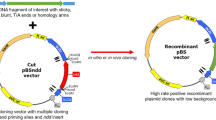Abstract
Plasmid vectors for positive selection of cloned inserts in Escherichia coli were devised, based on an expression plasmid (pMT416) for the bacterial ribonuclease barnase. In addition to the barnase gene under control of a synthetic tac promoter, these plasmids carry the gene for the barnase inhibitor, barstar, the constitutive expression of which protects the bacterium from the detrimental effects of moderate barnase production. Full expression of the barnase gene overcomes protection by barstar and becomes lethal. Having a unique SmaI/XmaI site in the barnase structural gene, pMT416 itself can be used as a selective vector: uncut or religated pMT416 will preclude growth while plasmids with inserts in the barnase gene will allow the cells to survive. The entire pUC polylinker was inserted into the barnase gene in place of the Val-36 codon. This insert of nineteen largely hydrophilic amino acids does not prevent the lethal effect of full expression of the gene. The resulting plasmid, pMT440, is a generally useful selective cloning vector representing the “kill-the-rest” approach.
Similar content being viewed by others
Author information
Authors and Affiliations
Additional information
Received: 25 April 1998 / Accepted: 26 May 1998
Rights and permissions
About this article
Cite this article
Deyev, S., Yazynin, S., Kuznetsov, D. et al. Ribonuclease-charged vector for facile direct cloning with positive selection. Mol Gen Genet 259, 379–382 (1998). https://doi.org/10.1007/s004380050825
Issue Date:
DOI: https://doi.org/10.1007/s004380050825




